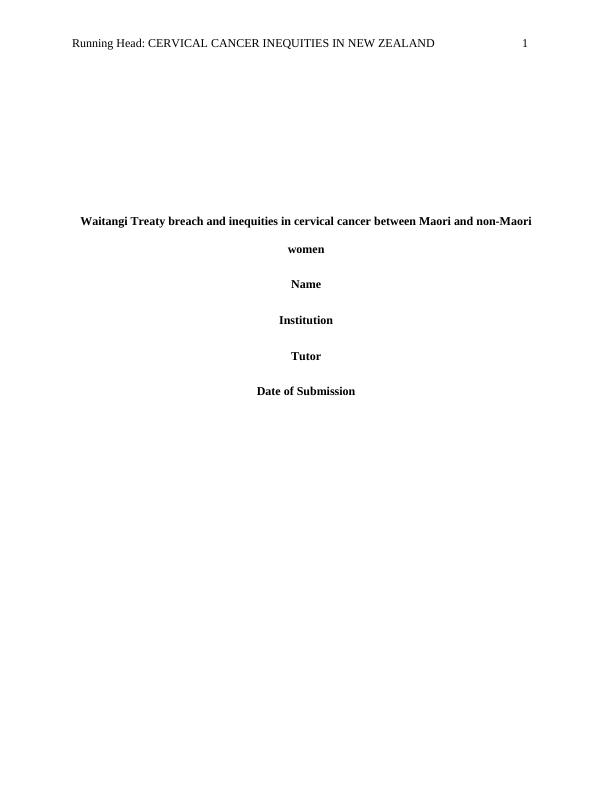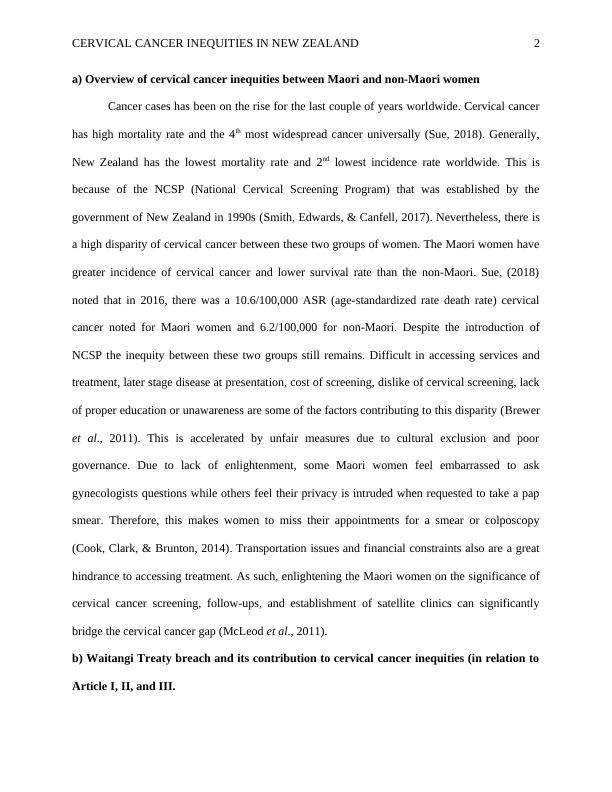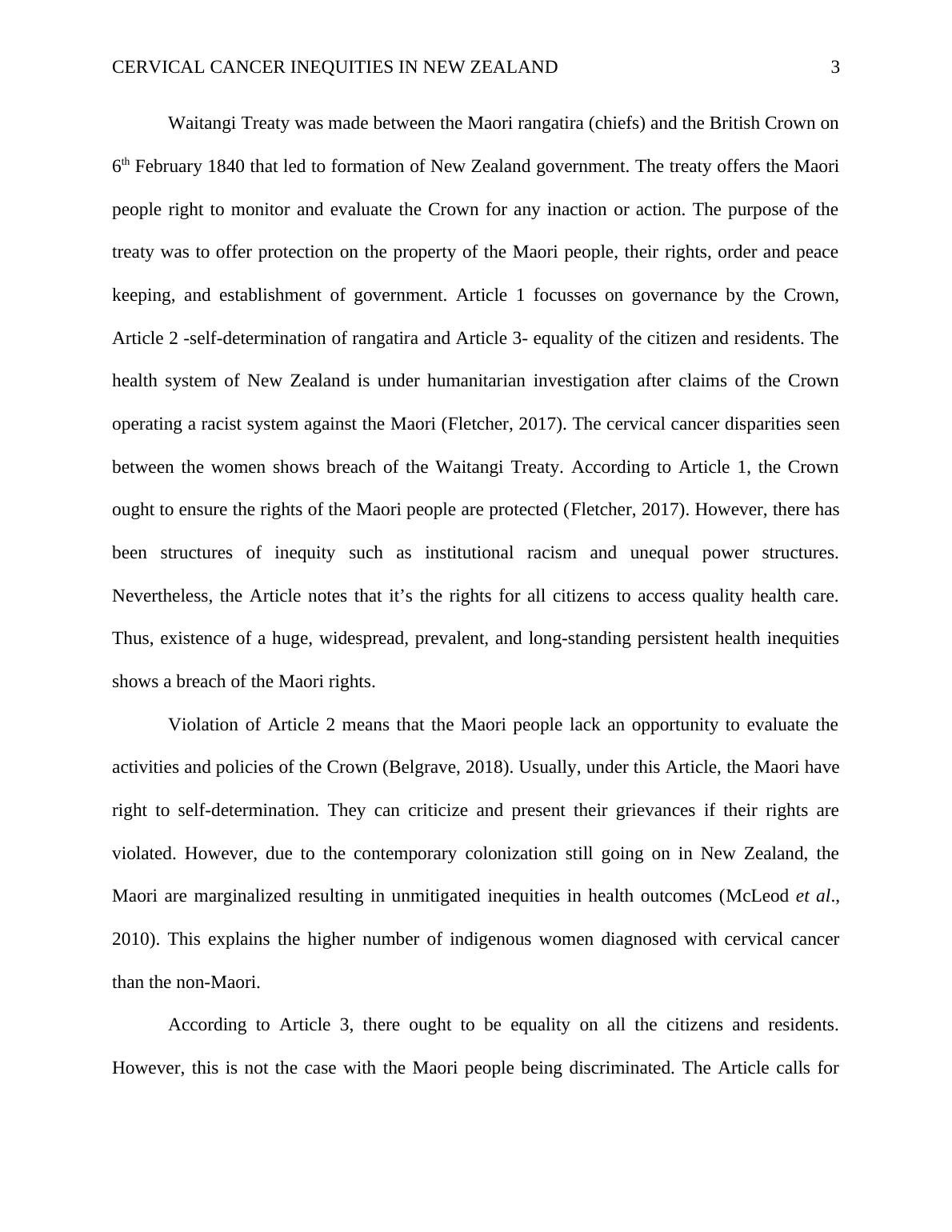Cervical Cancer Inequities in New Zealand
Added on 2022-10-15
7 Pages1774 Words331 Views
Running Head: CERVICAL CANCER INEQUITIES IN NEW ZEALAND 1
Waitangi Treaty breach and inequities in cervical cancer between Maori and non-Maori
women
Name
Institution
Tutor
Date of Submission
Waitangi Treaty breach and inequities in cervical cancer between Maori and non-Maori
women
Name
Institution
Tutor
Date of Submission

CERVICAL CANCER INEQUITIES IN NEW ZEALAND 2
a) Overview of cervical cancer inequities between Maori and non-Maori women
Cancer cases has been on the rise for the last couple of years worldwide. Cervical cancer
has high mortality rate and the 4th most widespread cancer universally (Sue, 2018). Generally,
New Zealand has the lowest mortality rate and 2nd lowest incidence rate worldwide. This is
because of the NCSP (National Cervical Screening Program) that was established by the
government of New Zealand in 1990s (Smith, Edwards, & Canfell, 2017). Nevertheless, there is
a high disparity of cervical cancer between these two groups of women. The Maori women have
greater incidence of cervical cancer and lower survival rate than the non-Maori. Sue, (2018)
noted that in 2016, there was a 10.6/100,000 ASR (age-standardized rate death rate) cervical
cancer noted for Maori women and 6.2/100,000 for non-Maori. Despite the introduction of
NCSP the inequity between these two groups still remains. Difficult in accessing services and
treatment, later stage disease at presentation, cost of screening, dislike of cervical screening, lack
of proper education or unawareness are some of the factors contributing to this disparity (Brewer
et al., 2011). This is accelerated by unfair measures due to cultural exclusion and poor
governance. Due to lack of enlightenment, some Maori women feel embarrassed to ask
gynecologists questions while others feel their privacy is intruded when requested to take a pap
smear. Therefore, this makes women to miss their appointments for a smear or colposcopy
(Cook, Clark, & Brunton, 2014). Transportation issues and financial constraints also are a great
hindrance to accessing treatment. As such, enlightening the Maori women on the significance of
cervical cancer screening, follow-ups, and establishment of satellite clinics can significantly
bridge the cervical cancer gap (McLeod et al., 2011).
b) Waitangi Treaty breach and its contribution to cervical cancer inequities (in relation to
Article I, II, and III.
a) Overview of cervical cancer inequities between Maori and non-Maori women
Cancer cases has been on the rise for the last couple of years worldwide. Cervical cancer
has high mortality rate and the 4th most widespread cancer universally (Sue, 2018). Generally,
New Zealand has the lowest mortality rate and 2nd lowest incidence rate worldwide. This is
because of the NCSP (National Cervical Screening Program) that was established by the
government of New Zealand in 1990s (Smith, Edwards, & Canfell, 2017). Nevertheless, there is
a high disparity of cervical cancer between these two groups of women. The Maori women have
greater incidence of cervical cancer and lower survival rate than the non-Maori. Sue, (2018)
noted that in 2016, there was a 10.6/100,000 ASR (age-standardized rate death rate) cervical
cancer noted for Maori women and 6.2/100,000 for non-Maori. Despite the introduction of
NCSP the inequity between these two groups still remains. Difficult in accessing services and
treatment, later stage disease at presentation, cost of screening, dislike of cervical screening, lack
of proper education or unawareness are some of the factors contributing to this disparity (Brewer
et al., 2011). This is accelerated by unfair measures due to cultural exclusion and poor
governance. Due to lack of enlightenment, some Maori women feel embarrassed to ask
gynecologists questions while others feel their privacy is intruded when requested to take a pap
smear. Therefore, this makes women to miss their appointments for a smear or colposcopy
(Cook, Clark, & Brunton, 2014). Transportation issues and financial constraints also are a great
hindrance to accessing treatment. As such, enlightening the Maori women on the significance of
cervical cancer screening, follow-ups, and establishment of satellite clinics can significantly
bridge the cervical cancer gap (McLeod et al., 2011).
b) Waitangi Treaty breach and its contribution to cervical cancer inequities (in relation to
Article I, II, and III.

CERVICAL CANCER INEQUITIES IN NEW ZEALAND 3
Waitangi Treaty was made between the Maori rangatira (chiefs) and the British Crown on
6th February 1840 that led to formation of New Zealand government. The treaty offers the Maori
people right to monitor and evaluate the Crown for any inaction or action. The purpose of the
treaty was to offer protection on the property of the Maori people, their rights, order and peace
keeping, and establishment of government. Article 1 focusses on governance by the Crown,
Article 2 -self-determination of rangatira and Article 3- equality of the citizen and residents. The
health system of New Zealand is under humanitarian investigation after claims of the Crown
operating a racist system against the Maori (Fletcher, 2017). The cervical cancer disparities seen
between the women shows breach of the Waitangi Treaty. According to Article 1, the Crown
ought to ensure the rights of the Maori people are protected (Fletcher, 2017). However, there has
been structures of inequity such as institutional racism and unequal power structures.
Nevertheless, the Article notes that it’s the rights for all citizens to access quality health care.
Thus, existence of a huge, widespread, prevalent, and long-standing persistent health inequities
shows a breach of the Maori rights.
Violation of Article 2 means that the Maori people lack an opportunity to evaluate the
activities and policies of the Crown (Belgrave, 2018). Usually, under this Article, the Maori have
right to self-determination. They can criticize and present their grievances if their rights are
violated. However, due to the contemporary colonization still going on in New Zealand, the
Maori are marginalized resulting in unmitigated inequities in health outcomes (McLeod et al.,
2010). This explains the higher number of indigenous women diagnosed with cervical cancer
than the non-Maori.
According to Article 3, there ought to be equality on all the citizens and residents.
However, this is not the case with the Maori people being discriminated. The Article calls for
Waitangi Treaty was made between the Maori rangatira (chiefs) and the British Crown on
6th February 1840 that led to formation of New Zealand government. The treaty offers the Maori
people right to monitor and evaluate the Crown for any inaction or action. The purpose of the
treaty was to offer protection on the property of the Maori people, their rights, order and peace
keeping, and establishment of government. Article 1 focusses on governance by the Crown,
Article 2 -self-determination of rangatira and Article 3- equality of the citizen and residents. The
health system of New Zealand is under humanitarian investigation after claims of the Crown
operating a racist system against the Maori (Fletcher, 2017). The cervical cancer disparities seen
between the women shows breach of the Waitangi Treaty. According to Article 1, the Crown
ought to ensure the rights of the Maori people are protected (Fletcher, 2017). However, there has
been structures of inequity such as institutional racism and unequal power structures.
Nevertheless, the Article notes that it’s the rights for all citizens to access quality health care.
Thus, existence of a huge, widespread, prevalent, and long-standing persistent health inequities
shows a breach of the Maori rights.
Violation of Article 2 means that the Maori people lack an opportunity to evaluate the
activities and policies of the Crown (Belgrave, 2018). Usually, under this Article, the Maori have
right to self-determination. They can criticize and present their grievances if their rights are
violated. However, due to the contemporary colonization still going on in New Zealand, the
Maori are marginalized resulting in unmitigated inequities in health outcomes (McLeod et al.,
2010). This explains the higher number of indigenous women diagnosed with cervical cancer
than the non-Maori.
According to Article 3, there ought to be equality on all the citizens and residents.
However, this is not the case with the Maori people being discriminated. The Article calls for

End of preview
Want to access all the pages? Upload your documents or become a member.
Related Documents
Introduction to Governance and Managementlg...
|15
|3809
|82
Governance and Management Report of New Zealandlg...
|15
|3836
|109
(PDF) Inequalities in healthlg...
|5
|755
|20
Health Experiences of Maori and Non-Maori Peoplelg...
|6
|1515
|75
